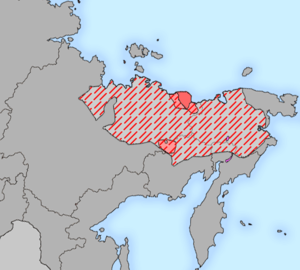Yukaghir languages
| Yukaghir | |
|---|---|
| Ethnicity | Anauls |
| Geographic distribution | Russian Far East |
| Linguistic classification | ? Uralic–Yukaghir; Otherwise one of the world's primary language families |
| Proto-language | Proto-Yukaghir |
| Subdivisions | |
| Glottolog | yuka1259 |
 Extent of Yukaghir languages in the 17th (hatched) and 20th (solid) centuries | |
The Yukaghir languages (
In the Russian 2020-2021 census, 516 people reported speaking a Yukaghir language as their native language.[3]

Classification and grammatical features
The relationship of the Yukaghir languages with other language families is uncertain, though it has been suggested that they are distantly related to the Uralic languages, thus forming the putative Uralic–Yukaghir language family.[4]
Tundra and Kolyma Yukaghir are the only two remnants of what used to be one of the dominant languages/language families of northeastern Siberia, spreading from the
These two languages share only a relatively small part of the vocabulary and are not mutually intelligible. The basic grammatical structures, however, are very similar. Both languages have residual
Members
The two extant varieties of Yukaghir are:
- Lenabasin in the west.
- Kolyma region.
Extinct varieties include Omok and Chuvan, which survived until perhaps the 18th century.
Lexical differences
Some lexical differences between Kolyma Yukaghir and Tundra Yukaghir:[8]: 150
gloss Kolyma Yukaghir Tundra Yukaghir one irkēj mōrqōñ two ataqlōj kijōñ five iñhañbōj imd’ald’añ many niŋel pojōl all t’umu jawnə day pod’erqə t’ajləŋ sun jelōd’ə jerpəjəŋ water ōd’ī lawjəŋ fish anil al’həŋ reindeer at’ə il’eŋ dog pubel laməŋ person šoromə ködeŋ people omnī t’īŋ eye aŋd’ə jȫd’īŋ tooth todī sal’hərīŋ night emil t’iŋit’əl foot nojl t’ohul name ñū kirijəŋ to sit modo- sahañeto kill kuledə- puñīto die amdə- jabəto know leidī- kurilīto drink ožə- law-
Text sample (Northern Yukaghir)
Article 1 of the Universal Declaration of Human Rights:
Көдэҥ тэн – ньидитэ бандьэ параwааньэрэҥ тудэ чуҥдэн ньилдьилэк эннулҥинь-мэдьуолнуни. Көдэҥ энмун чундэ мэ льэй, таатльэр лукундьии ньинэмдьийилпэ дитэ эннуйуол-мораwньэҥи.
Latin:
Ködeng ten – n'idite band'e parawaan'ereng tude chungden n'ild'ilek ennulngin'-med'uolnuni. Ködeng enmun chunde me l'ey, taatl'er lukund'ii n'inemd'iyilpe dite ennuyuol-morawn'engi.
English translation:
All human beings are born free and equal in dignity and rights. They are endowed with reason and conscience and should act towards one another in a spirit of brotherhood.
See also
- Paleosiberian languages
- Indigenous peoples of Siberia
- Uralic languages
- Uralic–Yukaghir languages
- Yukaghirs
References
- ^ "Всероссийская перепись населения 2002 года". www.perepis2002.ru. Archived from the original on 2012-01-26. Retrieved 2017-11-02.
- ^ "Endangered languages in Northeast Asia: report". www.helsinki.fi. Retrieved 2017-11-02.
- ^ "Росстат — Всероссийская перепись населения 2020". rosstat.gov.ru. Retrieved 2023-01-03.
- ^ Collinder, Björn (1940) Jukagirisch und Uralisch. Uppsala: Almqvist & Wiksell.
- ^ Fortescue, Michael (2017). "Correlating Palaeo-Siberian languages and populations: recent advances in the Uralo-Siberian hypothesis". Man in India.
- ^ Dolgikh, Boris O. (1960) Rodovoj i plemennoj sostav narodov Sibiri v XVII v. Moskva: Izdatel'stvo Akademii Nauk SSSR
- ^ Nikoleava, Irina (2008) Chuvan and Omok languages? In: A. Lubotsky et al. (Eds.) Evidence and Counter-Evidence. Festschrift Frederik Kortland. Amsterdam: Rodopi, pp. 313–336.
- ISBN 978-1-138-82105-7.
Further reading
- Luobbal Sámmol Sámmol Ánte (Ante Aikio): The Uralic-Yukaghir lexical correspondences: genetic inheritance, language contact or chance resemblance? – Finnisch-Ugrische Forschungen 62, pp. 7–76. Online article
- Häkkinen, Jaakko: Early contacts between Uralic and Yukaghir. Suomalais-Ugrilaisen Seuran Toimituksia − Mémoires de la Société Finno-Ougrienne 264, pp. 91–101. Helsinki: Suomalais-ugrilainen seura, 2012. Online article (pdf)
- Jochel'son Vladimir I. 1900. Materialy po izucheniju jukagirskogo jazyka i fol’klora. ('Materials for the Study of Yukaghir Language and Folklore'). Sankt-Peterburg: Akademija nauk.
- Jochelson, Waldemar. 1926. The Yukaghir and the Yukaghirized Tungus. Memoirs of the American Museum of Natural History, 9, 13. Publications of the Jesup North Pacific Expedition. Leiden: Brill.
- Krejnovich, Erukhim A. 1958. Jukagirskij jazyk. ('The Yukaghir Language') Moscow and Leningrad: Nauka.
- Krejnovich, Erukhim A. 1982. Issledovanija i materialy po jukagirskomu jazyku. ('Investigations and Materials on the Yukaghir Language') Leningrad: Nauka.
- Kurilov, Gavril N. 2001. Jukagirsko-russkij slovar'. ('Yukaghir-Russian Dictionary') Novosibirsk: Nauka.
- Maslova, Elena. 2001. Yukaghir Texts. Wiesbaden: Harrassowitz.
- Maslova, Elena. 2003. A Grammar of Kolyma Yukaghir. Berlin/New York: Mouton de Gruyter.
- Maslova, Elena. 2003. Tundra Yukaghir. LINCOM Europa. Languages of the World/Materials 372.
- Nikolaeva, Irina. 2006. A Historical Dictionary of Yukaghir. Berlin/New York: Mouton de Gruyter.
- Vakhtin, Nikolaj B. 1991. The Yukagir language in sociolinguistic perspective. Steszew, Poland: International Institute of Ethnolinguistic and Oriental Studies.
- Willerslev, Rane 2007. Soul Hunters: Hunting, Animism, and Personhood among the Siberian Yukaghirs. Berkeley: University of California Press.
- Willerslev, Rane 2012. On the Run in Siberia. Minneapolis: University of Minnesota Press.

